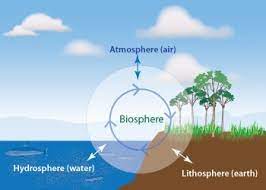The environment is the natural world in which people, animals, and plants coexist. It encompasses the surroundings in which living and non-living entities interact, grow, and ultimately exist. We delve into the four major components of the environment the lithosphere, hydrosphere, atmosphere, and biosphere, to gain a deeper understanding of our world.
The term “environment” finds its roots in the French words “virer” (to turn) and “in/viron” (to encircle), signifying the dynamic interaction between natural surroundings and all organisms, including humans. In essence, the environment represents the realm in which living and non-living entities cohabit, shaping their existence based on the prevailing conditions.

Four Components of the Environment
Our environment comprises four primary components, each with its own unique characteristics and significance:
a) Lithosphere: The lithosphere is the Earth’s outermost layer, known as the crust. It consists of various minerals and can extend up to 100 kilometers in depth. This component is present both on land (terrestrial crust) and beneath oceans (oceanic crust), with the Earth’s tectonic plates being a central feature of the lithosphere
b) Hydrosphere: The hydrosphere encompasses all forms of water bodies on Earth, including oceans, seas, rivers, lakes, ponds, and streams. It covers a staggering 70% of the Earth’s surface. The majority of Earth’s water, about 97.5%, exists in the oceans as salt water, while only 2.5% is freshwater. Of this freshwater, 30.8% is groundwater, 68.9% exists in frozen forms in glaciers, and a mere 0.3% is found in rivers, reservoirs, and lakes, making it readily accessible to humans.
c) Atmosphere: The atmosphere is the gaseous layer that envelops our planet. Earth’s atmosphere is unique due to its abundant oxygen content, which is essential for sustaining life. It primarily comprises nitrogen (78.08%), oxygen (20.95%), argon (0.93%), carbon dioxide (0.038%), and trace amounts of hydrogen, helium, and noble gases. The presence of variable levels of water vapour adds complexity to this dynamic layer.
d) Biosphere: The biosphere encompasses all regions on Earth where life exists. It refers to the ecosystems supporting life, whether in soil, air, water, or on land. Coined by geologist Edward Suess, the term “biosphere” designates the sum total of all living matter or biomass. It stretches from the polar ice caps to the equator, with each region hosting life forms uniquely adapted to their surroundings.
Interdisciplinary Nature of Environmental Science
Environmental science is an interdisciplinary field that draws from a wide range of disciplines, including geography, geology, biology, chemistry, physics, botany, zoology, genetics, sociology, rural development, urban planning, policy development, politics, cultural studies, economics, ethics, law, education, health, communication, and philosophy. This multifaceted science addresses the most significant challenges facing our planet in the 21st century, exploring the complex interactions between humans and nature while providing guidance for a sustainable future.
Understanding the components of our environment—the lithosphere, hydrosphere, atmosphere, and biosphere, is crucial for appreciating the intricate balance of life on Earth. Environmental science, with its interdisciplinary approach, plays a vital role in addressing global challenges and charting a path toward harmonious coexistence with our surroundings. As responsible stewards of our environment, it is our duty to preserve and protect these components for future generations.
For further information: https://www.gktoday.in/
Read our previous articles: https://scitechupdate.com/index.php/treated-wastewater-exerts-an-impact-on-our-rivers/ https://scitechupdate.com/index.php/india-makes-history-by-landing-a-spacecraft-at-the-moons-south-pole/
https://scitechupdate.com/index.php/zinc-air-batteries-could-be-cheaper-and-safer-than-lithium-ion/
https://scitechupdate.com/index.php/android-14-satellite-sms-for-everyone/
https://scitechupdate.com/index.php/chemistry-entrepreneurship/
https://scitechupdate.com/index.php/waste-paper-to-battery-components-for-smarts-phones-vehicles/https://scitechupdate.com/index.php/ai-demonstrated-95-accuracy-in-listening-typing-and-data-processing/
https://scitechupdate.com/index.php/top-7-technology-trends-of-2023-from-ai-to-5d-technology/


Thanks for sharing. I read many of your blog posts, cool, your blog is very good.